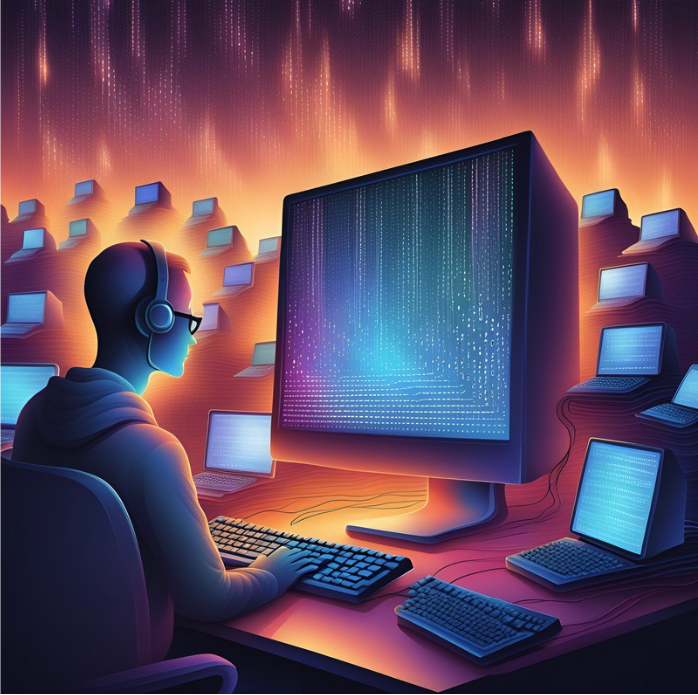The rise of Python began when Guido van Rossum created it in 1991. Today, Python is one of the most popular programming languages, especially favored by beginners and widely covered online. However, its rise to fame and current dominance in AI and web development took time. In its early years, Python lagged significantly behind languages like C, C++, and Java. This article will explore the rise of Python in the 90s, 2000s, 2010s, and 2020s, its widespread usage beyond AI, and the technical advancements that fueled its growth.
1990s: Python’s Early Struggles and Lagging Popularity
The rise of Python in the 1990s was slow, as the language struggled to gain traction against established giants like Java and C++. Released in 1991 with version 0.9.0, Python introduced essential features like object-oriented programming (OOP). However, Python’s infancy was marked by several obstacles that delayed its adoption.
Java and C++ Dominance
In the 90s, Java and C++ dominated the software industry. Java, launched by Sun Microsystems in 1995, became a favorite for its object-oriented approach and platform independence, fueled by the growing internet. Meanwhile, C++ reigned in systems programming due to its high performance. The rise of Python was held back by its lack of maturity and performance compared to these established languages.
Python 1.0 Release (1994)
Python 1.0’s release in 1994 introduced critical features like modules and exception handling. However, despite these improvements, Python lagged behind C and C++ in terms of performance, making it less suitable for large-scale enterprise projects.
Limited Library Support
One of the key reasons why the rise of Python was slow in the 90s was its limited library support. Unlike today, where Python thrives on its rich library ecosystem, back then, it lacked sufficient tools for web development, database management, and networking. This severely limited Python’s adoption in larger projects.
Despite these challenges, Python found a niche in academia and small projects. However, its lack of performance and library support kept it from becoming a mainstream choice during this period.

2000s: The Rise of Python in Web Development and Scientific Computing
The 2000s marked a significant shift in the rise of Python. The language gained popularity in web development and scientific computing, with essential technical advancements supporting its growth.
Python 2.0 Release (2000)
The release of Python 2.0 in 2000 brought essential new features:
- Garbage Collection: Automatic memory management, which reduced the likelihood of memory leaks.
- List Comprehensions: A feature that made Python code more readable and concise.
These features contributed to the rise of Python by improving usability and performance.
The Rise of Python in Web Development
Python’s rise in web development was driven by the emergence of powerful frameworks like Django (2005) and Flask(2010). Django’s modular, feature-rich design made Python an attractive choice for building web applications, while Flask offered developers a lightweight, flexible option. This contributed to the rise of Python as a competitor to Ruby on Rails and PHP. Google and YouTube’s adoption of Python further accelerated its growth.
Scientific Computing and Performance Gains
Python’s rise in scientific computing was powered by libraries like NumPy and SciPy, which made the language ideal for mathematical and statistical computations. Although Python still trailed behind C and C++ in performance, these libraries helped Python carve a niche in data-heavy fields.
2010s: Python 3.x and Its Dominance in AI
The 2010s were a breakthrough period for Python, with technical improvements and growing use in AI and data science solidifying its place as a dominant language.
Python 3.x Series (2008 Onward)
Python 3.0, released in 2008, marked a major turning point in the rise of Python. Despite initial adoption challenges due to its lack of backward compatibility, Python 3.x introduced several critical improvements:
- Faster Expression Evaluation: Enhancing code execution and memory management.
- Unicode by Default: Making Python more suitable for multilingual projects.
The Rise of Python in AI and Data Science
The rise of Python in AI was fueled by the development of libraries like TensorFlow (2015), Keras (2015), and PyTorch (2016). These tools made Python the language of choice for AI research and development. Similarly, Pandas(2008) and scikit-learn (2010) helped establish Python as the go-to language for data science. Python’s extensive library support and community resources played a crucial role in its success during this decade.
2020s: Performance Improvements and Expanding Usage
In the 2020s, Python continued to expand beyond AI and data science, finding use in numerous industries. The rise of Python in automation, finance, and cloud computing highlights its versatility.
Performance Enhancements
Python received significant performance boosts through alternative implementations like PyPy and optimizations in CPython. These improvements helped address the long-standing criticism of Python’s speed, especially for large-scale data processing and CPU-intensive tasks.
Expanding Use Cases
The rise of Python extended into many industries:
- Automation and DevOps: Tools like Ansible and SaltStack, built with Python, made IT automation more efficient.
- Finance and Trading: Python’s powerful data analytics capabilities made it popular in financial modeling and algorithmic trading.
- Cloud Computing and Microservices: Python is widely used in serverless architecture on platforms like AWS Lambda and Google Cloud Functions.
- Cybersecurity: Python is a favorite for penetration testing and vulnerability scanning.
Conclusion: The Ongoing Rise of Python in Tech
Since its inception, the rise of Python has been steady but transformative. Although it struggled to compete with Java and C++ in the 90s, Python gained momentum in the 2000s with web development and scientific computing. By the 2010s, the rise of Python in AI and data science was undeniable, and by the 2020s, Python had expanded into automation, cloud computing, and beyond. Its ongoing technical improvements and growing library ecosystem ensure that the rise of Python will continue in the years to come.



